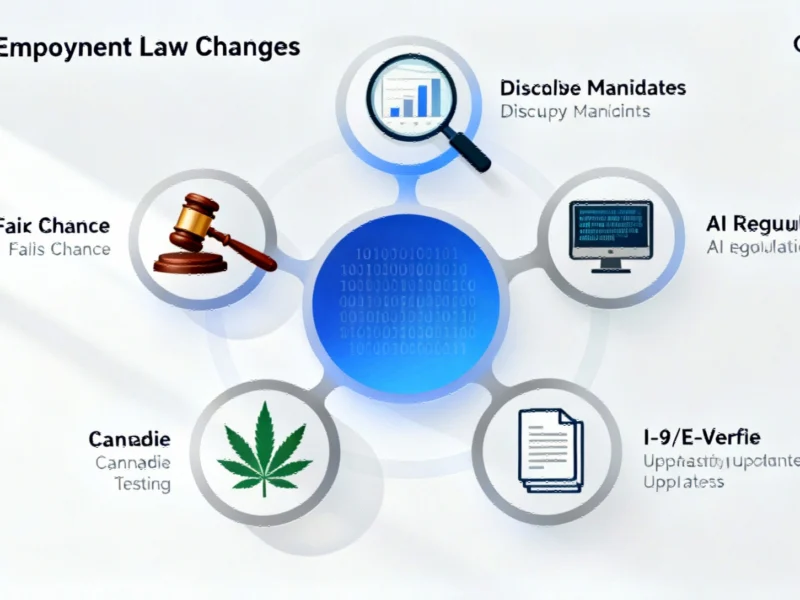Introduction: A Shifting Legal Framework
As we move through the third quarter of 2025, employers are navigating an increasingly complex web of employment law changes that demand strategic adaptation. These developments aren’t just isolated policy updates—they represent a fundamental shift in how compliance must be integrated into every aspect of the employment lifecycle. From enhanced background check restrictions to evolving pay transparency mandates and emerging AI regulations, the legal landscape is transforming how organizations hire, compensate, and manage their workforce.
Criminal History Screening: Tightening Fair Chance Protections
Several jurisdictions have significantly expanded protections for applicants with criminal histories, requiring employers to overhaul their screening processes. Philadelphia’s amended ordinance, effective January 6, 2026, introduces strict new limitations including a four-year lookback window for misdemeanors and complete exclusion of summary offenses. The city now requires detailed written notices and a ten-business-day response period before taking adverse action based on criminal records.
Washington state follows with even more comprehensive changes effective July 2026 for larger employers, prohibiting background checks until after conditional offers and banning consideration of arrests or juvenile convictions entirely. These developments reflect a broader trend toward protecting justice-impacted individuals that employers must address through updated procedures and documentation practices.
Minneapolis has taken this protection further by adding “justice-impacted status” as a protected class effective August 1, 2025. This sweeping category includes arrests, charges, convictions, probation, and incarceration regardless of outcome or timing. Employers must now conduct detailed six-factor individualized assessments for any criminal history consideration, making blanket exclusions legally indefensible.
Pay Transparency: Expanding Disclosure Requirements
The movement toward pay transparency continues to gain momentum across multiple states and municipalities. Massachusetts joins the trend with requirements effective October 29, 2025, mandating that employers with 25 or more workers disclose salary ranges in all job postings, promotions, and internal transfers. Larger employers face additional demographic pay data reporting obligations, with penalties reaching $25,000 per violation.
Cleveland’s new ordinance, effective October 27, 2025, prohibits salary history inquiries while requiring pay range disclosures in job postings—even for part-time and temporary positions. Vermont and Washington have also refined their existing laws, creating a complex patchwork of requirements that employers must navigate. These industry developments in compensation transparency reflect growing regulatory focus on pay equity.
Delaware becomes the latest state to join this trend with legislation taking effect in 2027, requiring salary ranges and benefit descriptions in job postings for positions located in or offered by Delaware employers. The Washington Supreme Court’s recent Branson decision further intensifies compliance pressure by broadly defining who qualifies as an “applicant” under state law, increasing litigation risks for non-compliant postings.
Cannabis Testing: Evolving Workplace Policies
As cannabis legalization expands, workplace testing policies face increasing scrutiny and regulation. Texas expanded its Compassionate-Use Program effective September 1, 2025, adding qualifying conditions and authorized products while maintaining employer rights to enforce zero-tolerance policies. However, Iowa’s new protections for medical cannabis patients require employers to provide 14 days’ written notice before taking adverse action based on THC-positive tests, citing specific legal requirements rather than general safety concerns.
Minnesota employers face even stricter limitations, with most prohibited from testing for cannabis altogether due to recreational use protections. Those exempt from these restrictions must follow precise notification procedures when acting against medical cannabis users. These regulatory changes coincide with broader market trends toward reevaluating workplace drug testing in light of changing societal attitudes and state laws.
Data Privacy and AI: Emerging Employment Risks
The intersection of employment law and technology is creating new compliance challenges, particularly around data privacy and artificial intelligence. California’s Privacy Protection Agency made headlines with a $1.35 million fine against a nationwide retailer for CCPA violations related to job applicant data collection—marking the first major employment-related enforcement action under the state’s privacy law.
Artificial intelligence regulation is advancing on multiple fronts, with Texas’ TRAIGA prohibiting intentional AI discrimination effective January 1, 2026, while California’s Civil Rights Department has confirmed employer liability for discriminatory AI outcomes regardless of vendor involvement. The Colorado AI Act, now delayed until June 30, 2026, will impose mandatory risk assessments and algorithmic disclosures for high-risk AI systems in employment.
California Governor Newsom’s veto of SB 7 leaves employers relying on existing CRD regulations for AI guidance, emphasizing the need for careful implementation of automated decision systems. As organizations navigate these technological changes, understanding how smart energy management can counter AI’s power demands becomes increasingly relevant to sustainable operations.
Broader Implications and Strategic Preparation
These legal developments require employers to take a proactive approach to compliance, integrating legal requirements into core business processes rather than treating them as separate considerations. The expansion of protected categories, combined with increased transparency mandates and emerging technology regulations, creates both operational challenges and strategic opportunities for forward-thinking organizations.
Employers should view these changes as part of a broader transformation in the employment landscape that includes Microsoft’s Gaming Copilot entering beta phase and other technological innovations that are reshaping workplace dynamics. The integration of AI into employment decisions particularly highlights the tension between technological advancement and regulatory protection that will define compliance in the coming years.
These employment law shifts occur against a backdrop of significant fiscal strategy changes as UK government debt costs influence global economic conditions, potentially affecting hiring budgets and compensation planning. Meanwhile, many organizations are simultaneously navigating the S/4HANA migration dilemma as part of their digital transformation efforts.
For comprehensive analysis of how these major employment law shifts reshape hiring practices, employers should consult specialized legal resources and begin implementation planning well in advance of effective dates. The accelerating pace of regulatory change demands that organizations build flexibility and adaptability into their compliance frameworks to successfully navigate this evolving landscape.
Conclusion: Strategic Compliance in a Changing Environment
The Q3 2025 employment law landscape represents more than incremental updates—it signals a fundamental rethinking of how employers approach hiring, compensation, and workplace management. Successful navigation requires understanding both the specific legal requirements and the broader trends shaping employment regulation. By taking proactive steps to update policies, retrain staff, and integrate compliance into business processes, organizations can turn regulatory challenges into competitive advantages while building more equitable and transparent workplaces.
This article aggregates information from publicly available sources. All trademarks and copyrights belong to their respective owners.



